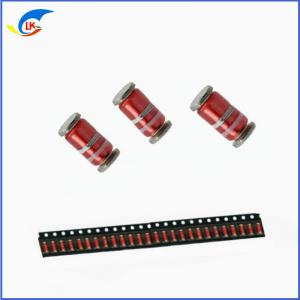
Add to Cart
SMD 2.6x5.0mm GDT Glass Gas Discharge TubeG3S300 300V Spark Gap Protectors
Size Of The SMD MELF Leadless Glass Discharge Tube G3S (mm)
Electrical Performances Of The SMD MELF Leadless Glass Discharge Tube G3S
| Part No. | DC Spark Over Voltage (100v/s)V | Impulse Spark Over Voltage (1kv/μs)V | Insulation Resistance MΩ | Electrode Capacitance 1MHz 0.5V PF | Impulse Discharge Current (8/20μs 10 times) |
| G3S140 | 140±30% | ≤600 | ≥100 | ≤1 | 1KA |
| G3S200 | 200±30% | ≤600 | ≥100 | ≤1 | 1KA |
| G3S250 | 250±30% | ≤650 | ≥100 | ≤1 | 1KA |
| G3S300 | 300±30% | ≤900 | ≥100 | ≤1 | 1KA |
| G3S400 | 400±30% | ≤1000 | ≥100 | ≤1 | 1KA |
| G3S500 | 500±30% | ≤1400 | ≥100 | ≤1 | 1KA |
Why Use Surge Protection?
Surge protectors protect personnel and equipment from damaging high-voltage surges from lightning, inductive switching, nuclear electromagnetic pulse, electrostatic discharge, or interference from power supply lines. From a design point of view, protection circuits only cost money and, if customer requirements or regulatory agencies do not require them, they will easily be forgotten. Yet, appropriate surge protection is beneficial. Protected equipment will not be affected by the highvoltage surges listed above. This will result in:
• Reduced field failures
• Improved product quality and reliability
• Reduced cost of quality
The figure below illustrates the cost effectiveness of adding surge protection by demonstrating the unit repair cost to break even over a range of return rates for added protection costs of $0.50/unit and $1.00/unit.
Through ongoing research and engineering improvements, Littelfuse has developed a family of Surge Protection Products that offer impressive characteristics for a variety of applications. Four differentiating characteristics are found in every Littelfuse Surge Protection Product:
• High surge current rating
• Long life
• Fast response
• Rugged construction
Application Of The SMD MELF Leadless Glass Discharge Tube G3S
* Power Supplies
* Motor sparks eliminating
* Relay switching spark absorbing
* Data line pulse guarding
* Electronic devices requiring UL497A and UL497B compliant
* Telephone/Fax/Modem
* High frequency signal transmitters/receivers
* Satellite antenna
* Radio amplifiers
* Alarm systems
* Cathode ray tubes in Monitors/TVs
Features Of The SMD MELF Leadless Glass Discharge Tube G3S
* Approximately zero leaking current before clamping voltage
* Less decay at on/off state.
* High capability to withstand repeated lightning strikes.
* Low electrode capacitance (≤1.0pF) and high isolation(≥100MΩ).
* RoHS compliant.
* Bilateral symmetrical.
* Temperature, humidity and lightness insensitive.
* Working temperature: -25℃~ +65 ℃
* Storage temperature: -25 ~ + ℃ 85℃
* Meets MSL level 1, per J-STD-020
A Comparison of Surge Arrester Technologies
In today’s world of sensitive electronics, an increasingly important topic has become the protection of electronic components from overvoltage surges. There is a multitude of devices on the market for this purpose but what are the differences between them and which is best for what application? The following describes, analyzes, and compares these devices in detail. Basically there are two types of surge protection classifications with each consisting of its own group of devices:
Product performance:
Ceramic gas discharge tube is the most widely used switching device in lightning protection equipment. Whether it is lightning protection for AC or DC power supplies or lightning protection for various signal circuits, it can be used to discharge lightning current into the earth. Its main characteristics are: large discharge current, small inter-electrode capacitance (≤3pF), high insulation resistance (≥109Ω), large breakdown voltage dispersion (±20%), and slightly slower reaction speed (the shortest is 0.1~0.2μs). ). According to the number of electrodes, there are two types: diode discharge tubes and triode discharge tubes (equivalent to two diode discharge tubes connected in series). Its appearance is cylindrical, and it has two structural forms: with and without leads (some also have a protection card for short circuit when overheating).
Glass-sealed discharge tube (product description) Micro surge absorber is an overvoltage protection device that suppresses abnormal high-voltage pulses and protects low-voltage circuits from damage by instantaneous high-voltage (such as lightning, high-voltage noise from the power grid, high-voltage static electricity, etc.) . It is a guided protection component developed using the principle of micro-gap discharge and the activation of semiconductor chips. It has the advantages of fast response, impact resistance, stable performance, good repeatability and long life.
A semiconductor discharge tube (also called a solid discharge tube) is a PNPN component, which is regarded as a free voltage-controlled thyristor without a gate electrode. When the voltage exceeds its off-state peak voltage (or avalanche voltage) When the semiconductor discharge occurs, the transient voltage will be clamped to within the switching voltage (or breakover voltage) value of the component. When the voltage continues to increase, the semiconductor discharge tube enters the conduction state due to the negative resistance effect. Only when the current is less than the holding current, the component resets and returns to its high impedance state.